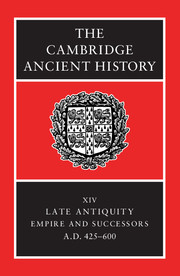Book contents
- Frontmatter
- PART I CHRONOLOGICAL OVERVIEW
- PART II GOVERNMENT AND INSTITUTIONS
- 6 Emperor and court
- 7 Government and administration
- 8 Administration and politics in the cities of the fifth to the mid seventh century: 425–640
- 9 Roman law
- 10 Law in the western kingdoms between the fifth and the seventh century
- 11 The army, c. 420–602
- PART III EAST AND WEST: ECONOMY AND SOCIETY
- PART IV THE PROVINCES AND THE NON-ROMAN WORLD
- PART V RELIGION AND CULTURE
- Conclusion
- Chronological Table
- BIBLIOGRAPHY
- Index
- References
6 - Emperor and court
from PART II - GOVERNMENT AND INSTITUTIONS
Published online by Cambridge University Press: 28 March 2008
- Frontmatter
- PART I CHRONOLOGICAL OVERVIEW
- PART II GOVERNMENT AND INSTITUTIONS
- 6 Emperor and court
- 7 Government and administration
- 8 Administration and politics in the cities of the fifth to the mid seventh century: 425–640
- 9 Roman law
- 10 Law in the western kingdoms between the fifth and the seventh century
- 11 The army, c. 420–602
- PART III EAST AND WEST: ECONOMY AND SOCIETY
- PART IV THE PROVINCES AND THE NON-ROMAN WORLD
- PART V RELIGION AND CULTURE
- Conclusion
- Chronological Table
- BIBLIOGRAPHY
- Index
- References
Summary
The figure of the late Roman emperor dominated his society as few rulers before or since. To convey what it would be like to die and meet God, a contemporary evoked the emperor emerging from his palace, and an age obsessed with religion constantly linked emperor and God: ‘God needs nothing; the emperor needs only God.’ The emperor’s body was human, but his imperial power made him ‘like God’. Yet the all-powerful ‘Master of Earth and Sea and Every People’ never appeared alone: he was always accompanied by others, who bathed in the reflected glory of his splendour. Onlookers envied the luck of his closest attendants and companions, despite the realization that exalted rank at court was precarious.
The concept of court conveniently encapsulates the convergence of people and structures at the pinnacle of late Roman society around this awesome figure. The remarkable social group surrounding the emperor encompassed but transcended the chief institutions of government and now assumed more elaborate forms. The recent and definitive establishment of imperial residences in the new capitals of Constantinople and Ravenna helped precipitate this change. A travelling monarchy yielded permanently to a sedentary one, and stable palace milieux began to drive roots into capital cities. This occurred in both halves of the empire and affected all other developments, although the evidence is much richer for the eastern empire.
- Type
- Chapter
- Information
- The Cambridge Ancient History , pp. 135 - 163Publisher: Cambridge University PressPrint publication year: 2001
References
- 5
- Cited by

